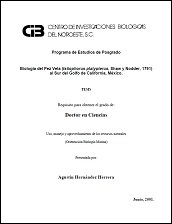Desempeño reproductivo y calidad de huevos en reproductores de origen silvestre y domesticado-F1 de jurel Seriola rivoliana bajo las mismas condiciones de cultivo
Reproductive broodstock performance and egg quality of wild-caught and first-generation domesticated Seriola rivoliana reared under same culture conditions
Autor
MARCOS FABIAN QUIÑONES ARREOLA
GUADALUPE FABIOLA ARCOS ORTEGA
VICENTE GRACIA LOPEZ
RAMON CASILLAS HERNANDEZ
LOURDES MARIANA DIAZ TENORIO
JOSE CUAUHTEMOC IBARRA GAMEZ
Metadatos
Mostrar el registro completo del ítemResumen
"El jurel Seriola rivoliana así como algunas especies relacionadas, son de gran interés en la acuicultura de peces marinos. Sin embargo, existen pocos estudios sobre su reproducción en cautiverio. En este trabajo se analizó y comparó el desempeño reproductivo y calidad del huevo en dos grupos de adultos de Seriola rivoliana, capturados en el medio silvestre y domesticados-F1 criados en óptimas condiciones de maduración en un laboratorio comercial. Un total de 28 adultos silvestres (>5 kg) se capturaron en la Bahía La Paz, Baja California Sur, México y 30 adultos de origen domesticado-F1 (>5 kg), se obtuvieron a partir de un lote de 1.000 juveniles (3,5 g de peso) producidos en la empresa Kona Blue (Hawái, EE.UU.) y transportados a la empresa Rancheros del Mar para su engorda y posterior maduración. Los reproductores de ambos orígenes, fueron evaluados durante ocho meses (mayo a diciembre 2012) y comparados en términos de desempeño reproductivo (número de desoves totales, frecuencia mensual de desoves, número total de huevos, número total de huevos por mL, tasa de fertilización) y composición bioquímica del huevo (proteínas totales, lípidos totales, carbohidratos totales y triglicéridos), así como el diámetro del huevo. Los resultados obtenidos, indican que los reproductores de origen silvestre presentaron un mejor desempeño reproductivo en términos de porcentaje de fertilización, número total de desoves, frecuencia mensual de desoves y número total de huevos producidos. Sin embargo, la composición bioquímica y el diámetro del huevo no mostraron diferencias estadísticas (P < 0,05) entre los dos grupos. El desempeño reproductivo y la calidad de los huevos analizados en este estudio son aspectos importantes para mejorar el manejo en cautiverio de esta especie." "Almaco jack, Seriola rivoliana as well as some related species is of great interest in marine fish aquaculture. However, there are few studies about their reproduction in captivity. In this research work, reproductive performance and egg quality in two groups of adult Seriola rivoliana, caught in the wild and domesticated-F1 analyzed and compared, reared under optimal maturation conditions in a commercial private Laboratory. A total of 28 wild adult (>5 kg) were caught at La Paz Bay, Baja California Sur, Mexico, and 30 adult domesticated-F1 broodstock (>5 kg), were obtained from an original stock of 1,000 juveniles (3.5 g body weight) produced at Kona Blue (Hawaii, USA) sea farm. Fishes were transported to the Rancheros del Mar commercial private hatchery, where they were grown to adult size. Both groups were evaluated during eight months (May to December 2012) and compared in terms of reproduction performance (total number of spawning events, monthly spawning frequency, total number of eggs, total number of eggs per mL, and fertilization rate), egg biochemical composition (total proteins, total lipids, total carbohydrates, and triacylglycerides) and egg diameter. Results indicated that wild caught broostock showed a better reproductive performance in terms of fertilization rate, total number of spawning, monthly spawning frequency and total number of eggs produced. However, biochemical composition and egg diameter did not show statistical differences (P < 0.05) between two groups. The reproductive performance of broodstock and quality of eggs analyzed in this study are important traits to improve the aquaculture management of this species."
Colecciones
Ítems relacionados
Mostrando ítems relacionados por Título, autor o materia.
-
PROMOCIÓN DEL PERIFITON PARA EL CULTIVO DE CAMARÓN BLANCO: HACIA UNA ACUICULTURA ECOLÓGICA
DOMENICO VOLTOLINA LOBINA; JUAN MANUEL AUDELO NARANJO; MARIA DEL ROSARIO PACHECO MARGES -
Suelo y Erosión
YOLANDA LOURDES MAYA DELGADO


